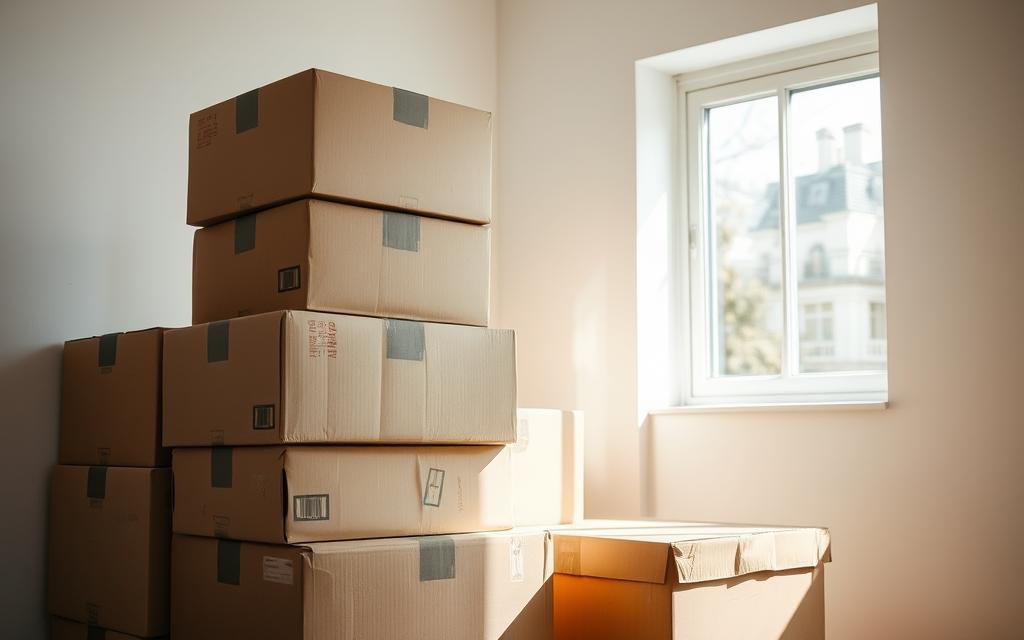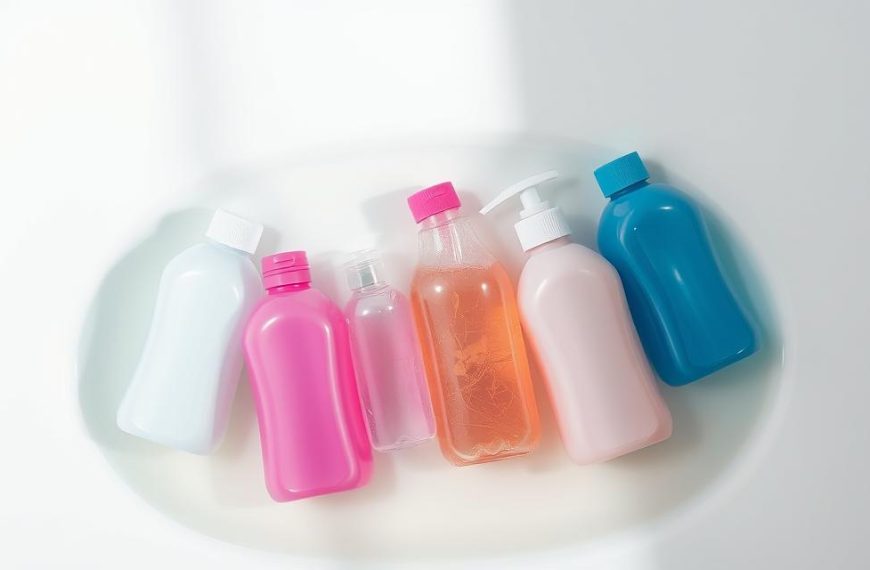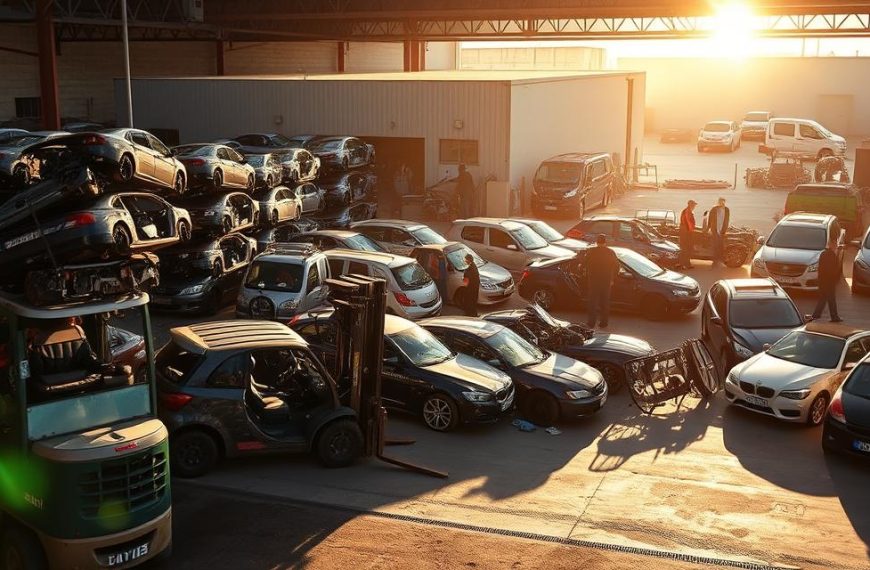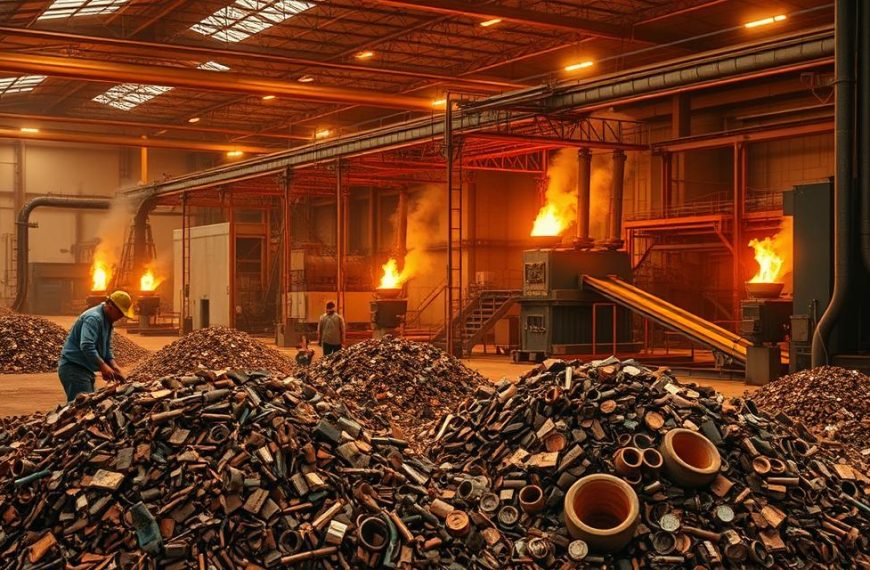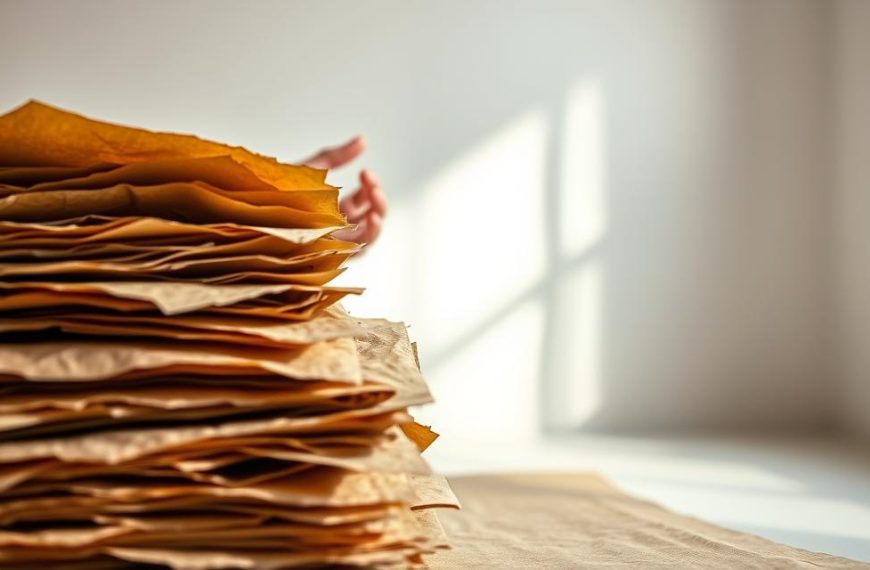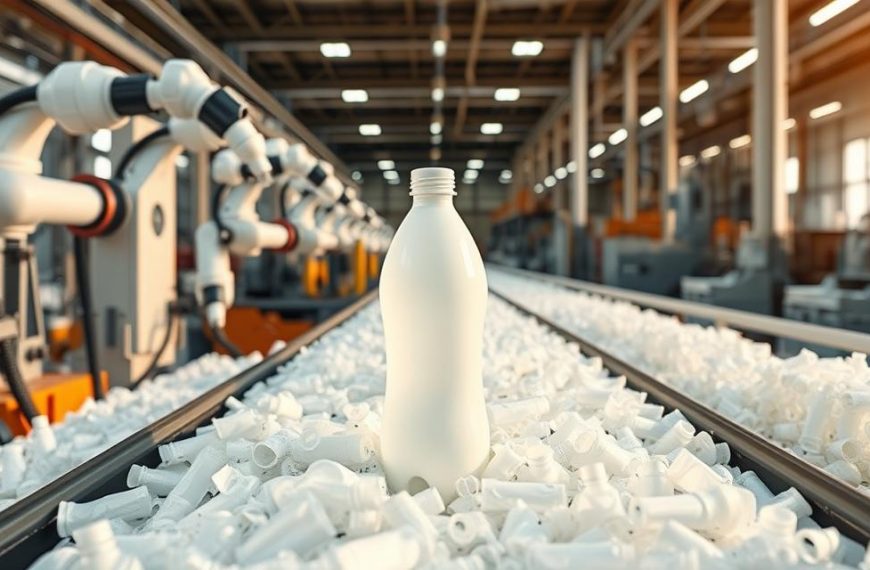Every year, the U.S. uses over 100 billion cardboard boxes, many of which end up in landfills. This staggering number highlights the need for better disposal methods. The forest products industry, employing over 925,000 workers, plays a vital role in managing this challenge.
Recycling cardboard not only reduces waste but also conserves resources. For every ton recycled, 3 cubic yards of landfill space are saved. This makes proper disposal crucial for environmental sustainability.
Through initiatives like Better Practices, Better Planet 2030, the industry is working toward greener solutions. From recycling centers to creative reuse strategies, there are many ways to manage cardboard responsibly.
Introduction to Recycling Moving Boxes
Cardboard is one of the most recyclable materials on the planet. It is 100% biodegradable and can be reused multiple times without losing its quality. This makes it a cornerstone of sustainable waste management practices.
Recycling cardboard offers significant environmental benefits. For example, it saves 75% of the energy required to produce new cardboard. Additionally, it reduces sulfur dioxide emissions by 50%, contributing to cleaner air.
According to the EPA, 68% of paper and board were recycled in 2021. This high rate underscores the importance of recycling in reducing landfill waste. Proper disposal of cardboard also aligns with the principles of a circular economy, where materials are continuously reused.
The American Forest & Paper Association (AF&PA) has set ambitious goals for 2030. They aim to increase the recycled content in packaging products, further promoting sustainability. By recycling cardboard, we contribute to these goals and help protect the environment.
| Action | Environmental Benefit |
|---|---|
| Recycling Cardboard | 75% energy savings, 50% less sulfur dioxide emissions |
| Landfill Disposal | Increased waste, higher carbon footprint |
For more detailed guidance on how to recycle cardboard, visit Earth911. Their resources provide valuable insights into making recycling a part of your daily routine.
Why Recycling Cardboard Moving Boxes Matters
The environmental impact of cardboard is often underestimated. Every year, the U.S. uses over 100 billion corrugated boxes. This massive consumption highlights the need for sustainable practices to manage this essential packaging material.
Recycling just one ton of cardboard saves 17 trees and 7,000 gallons of water. These resources are vital for maintaining ecological balance. Proper disposal also reduces the carbon footprint significantly, making it a key part of environmental conservation.
When cardboard ends up in landfills, it takes over five years to decompose. This slow process contributes to environmental pollution and wasted space. Recycling, on the other hand, prevents this issue and promotes a circular economy.
Many major retailers have implemented box recycling programs. These initiatives by leading companies set an example for others to follow. They show how businesses can contribute to sustainability while maintaining efficiency.
The recycled paper and board industry is valued at over $5 billion. This economic impact underscores the importance of recycling. Regional success stories in cardboard recovery rates further prove that collective efforts can make a difference.
For more tips on managing cardboard responsibly, check out this detailed guide. It provides practical steps to incorporate recycling into your routine.
Where to Recycle Moving Boxes: Options in the U.S.
Finding the right place to handle your cardboard is easier than you think. With 94% of Americans having access to recycling programs, there are plenty of options available. Whether you’re looking for a local recycling center or a waste management company, the U.S. offers diverse solutions to meet your needs.
Local Recycling Centers
Municipal recycling centers are a convenient option for many. These facilities often accept cardboard and other materials at no cost. To find one near you, tools like Earth911 can help pinpoint the closest location. Simply enter your ZIP code, and you’ll get a list of nearby centers along with their accepted materials.
Waste Management Companies
For those who prefer professional services, waste management companies like Republic Services and Waste Connections offer bulk cardboard pickup. Their policies vary, so it’s worth checking their websites for specific guidelines. Some companies even provide dedicated bins for cardboard, making the process seamless.
| Company | Cardboard Policy |
|---|---|
| Republic Services | Bulk pickup available; check local guidelines |
| Waste Connections | Dedicated bins for cardboard; curbside pickup |
| WM | Recycling programs tailored to residential needs |
Specialty platforms like U-Haul’s Box Exchange and BoxCycle also provide unique solutions. These platforms connect individuals looking to give away or find used cardboard, promoting reuse and reducing waste. Retailers like Home Depot and Lowe’s have also stepped up, offering take-back programs for used boxes.
Preparing Your Moving Boxes for Recycling
Proper preparation ensures your cardboard is ready for recycling. Taking a few simple steps can make the process smoother and more efficient. By following these guidelines, you can avoid contamination and ensure your materials are accepted at recycling centers.
Breaking Down Boxes
Flattening your boxes is the first step in preparing them for recycling. According to WM guidelines, flattened boxes save up to 80% of storage space. This makes them easier to transport and store in your bin.
Use tools like box cutters or utility knives to break down boxes quickly. For stubborn tape, try using a hairdryer or citrus solvent to remove it without damaging the cardboard. Salvage partially damaged boxes by cutting away unusable sections, ensuring only clean, dry cardboard is recycled.
Keeping Boxes Dry
Moisture is one of the biggest challenges in cardboard recycling. Wet cardboard can contaminate entire loads, leading to rejection at recycling facilities. Store your boxes in a dry area, such as a garage, or use plastic sheeting to protect them from rain or humidity.
If you’re handling bulk preparation for apartment complexes or moving companies, ensure all boxes are dry before placing them in the bin. This small step can make a big difference in the recycling process.
| Preparation Step | Benefit |
|---|---|
| Flattening Boxes | Saves 80% storage space |
| Removing Tape | Prevents contamination |
| Keeping Boxes Dry | Ensures acceptance at recycling centers |
“Proper preparation is key to successful recycling. Flattening and drying your boxes ensures they’re ready for the next step in the process.”
Creative Ways to Reuse Moving Boxes
Transforming old materials into new creations is both fun and eco-friendly. Cardboard is a versatile material that can be repurposed in countless ways. From DIY projects to composting, there are many ways to give it a second life.
DIY Projects
Cardboard is perfect for crafting and organizing. Use it to create custom drawer dividers or cable management solutions. It’s also great for children’s projects, like science fair displays or Halloween costumes.
For pet owners, cardboard can be turned into a cozy bed. Follow ASPCA guidelines to ensure it’s safe and comfortable. You can even use it to build a temporary playhouse for your furry friends.
Composting Cardboard
Cardboard is biodegradable and works well in compost piles. Shred it into small pieces or layer it directly into your garden. It acts as a natural weed barrier and decomposes in about two weeks.
For worm bins, cardboard provides a carbon-rich material that helps balance the compost. Avoid using glossy or plastic-coated cardboard, as it can harm the composting process.
| Composting Technique | Benefit |
|---|---|
| Shredding | Speeds up decomposition |
| Layering | Acts as a weed barrier |
| Worm Bins | Balances carbon content |
“Reusing cardboard is a simple way to reduce waste and get creative. Whether it’s for crafts or composting, the possibilities are endless.”
Donating or Selling Your Moving Boxes
Giving your used materials a second life can benefit both you and the community. Instead of discarding them, consider donating or selling your leftover packaging. These options not only reduce waste but also provide resources for others in need.
Donating to Charities
Many charities accept cardboard donations. Habitat ReStore, with over 900 locations nationwide, is a great option. They use donated materials to support affordable housing projects. Local shelters and organizations like Goodwill also welcome these contributions.
Before donating, vet the charity to ensure your items will be put to good use. Some organizations may have specific guidelines for accepting materials. Donations can also qualify for tax deductions, so keep proper documentation.
Selling Online
If your boxes are in good condition, selling them online is a practical choice. Platforms like BoxCycle specialize in connecting buyers and sellers. They charge a commission of 10-15% per sale, making it a convenient option.
Facebook Marketplace and OfferUp are also popular platforms. Compare their fees and policies to find the best fit. Pricing your boxes between $0.50 and $2 per box can attract customers quickly.
Corporate programs like Amazon’s Boxless initiative encourage reuse. These programs highlight the growing trend of sustainability in business practices. By selling or donating, you contribute to this positive change.
Understanding Local Recycling Regulations
Local recycling rules vary widely across the U.S., making it essential to understand your area’s guidelines. Whether you’re a homeowner or part of a management team, compliance ensures efficient waste handling and avoids fines. Researching municipal codes and staying updated on policies is the first step toward responsible recycling.
Curbside Recycling
Many municipalities offer curbside recycling programs for convenience. These programs typically provide blue bins with an 18-gallon capacity for weekly pickup. However, contamination rates must stay below 5% to avoid penalties, which can reach up to $500 in strict areas.
For multi-family housing, compliance strategies include designated collection areas and clear signage. Commercial properties often have stricter guidelines, so it’s important to call your local waste company for specifics. Special collection programs may also be available for oversized items.
Recycling Bins
Using the right recycling bins is crucial for efficient waste management. Blue bins are standard for cardboard and other recyclables. Ensure bins are labeled correctly to prevent contamination and streamline the sorting process.
Tools like the RecycleNation database can help you find local guidelines and approved bin types. For businesses, investing in high-capacity bins can improve efficiency and reduce waste handling costs.
| Program | Key Details |
|---|---|
| Curbside Recycling | Weekly pickup, 18-gal bins, contamination fines up to $500 |
| Recycling Bins | Blue bins for cardboard, labeled for sorting, multi-family compliance strategies |
| Special Collections | Oversized box programs, commercial vs. residential guidelines |
Understanding these regulations not only helps you stay compliant but also contributes to a cleaner environment. By following local guidelines, you play a vital role in sustainable waste management.
Common Mistakes to Avoid When Recycling Moving Boxes
Recycling cardboard efficiently requires avoiding common errors. Small mistakes can lead to contamination, increased costs, and wasted resources. By understanding these pitfalls, you can ensure your materials are processed correctly and contribute to a cleaner environment.
Wet Cardboard
Moisture is a major issue in recycling. Wet cardboard can contaminate entire loads, leading to rejection at facilities. According to WM, 25% of recycling stream contamination comes from wet materials. To test for moisture, use the bend or tear method. If the cardboard bends without breaking or tears easily, it’s likely too wet.
Wax-coated boxes are another concern. These are often mistaken for recyclable cardboard but should be disposed of separately. Always check for a glossy or plastic coating before adding them to your bin.
Improper Sorting
Sorting errors can disrupt the recycling process. For example, pizza boxes are often confused with shipping boxes. While shipping boxes are recyclable, pizza boxes with grease stains should be composted instead. Hazardous materials like batteries or chemicals can also cause cross-contamination.
To prevent these issues, follow cross-contamination prevention protocols. Separate materials carefully and ensure only clean, dry cardboard is placed in the recycling bin. This small effort can save municipalities up to $75 per ton in mixed waste processing costs.
Conclusion: Making a Positive Impact Through Recycling
Recycling plays a vital role in reducing landfill waste and conserving resources. From production to disposal, every step in the lifecycle of materials matters. By diverting tons of waste from landfills, communities can make a significant impact on the environment.
Future trends like RFID tracking in box recovery are set to improve efficiency. These innovations will make it easier to manage resources responsibly. At home, small actions like participating in neighborhood challenges can amplify these efforts.
For more information, sign up for the EPA WasteWise program. It provides valuable resources to help you contribute to a cleaner, greener future. Together, we can make a difference.

